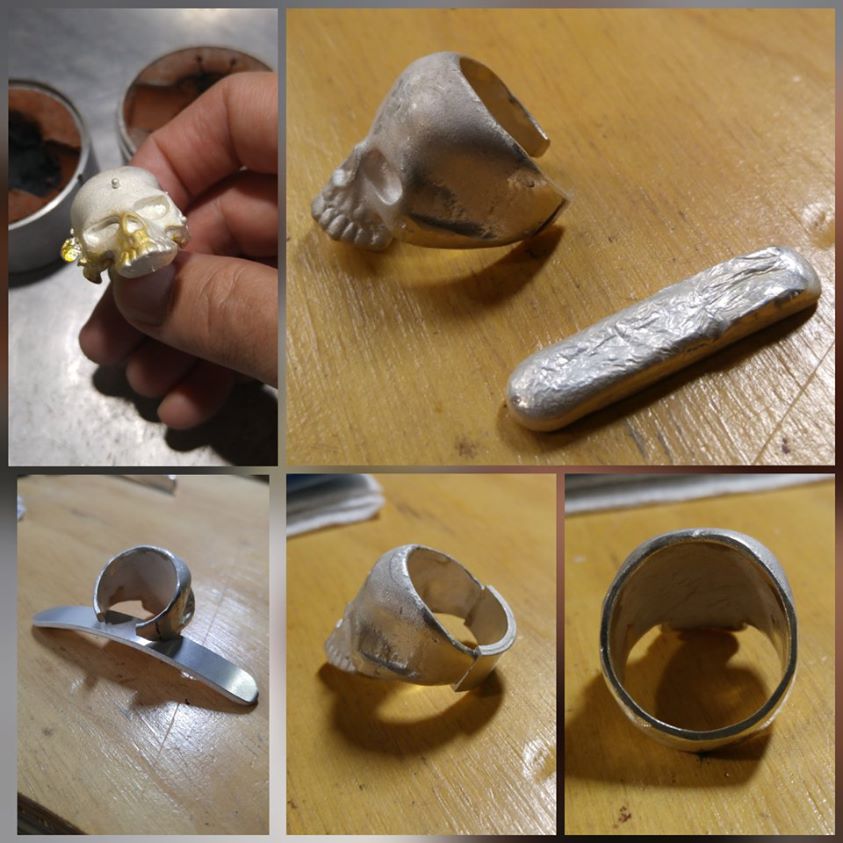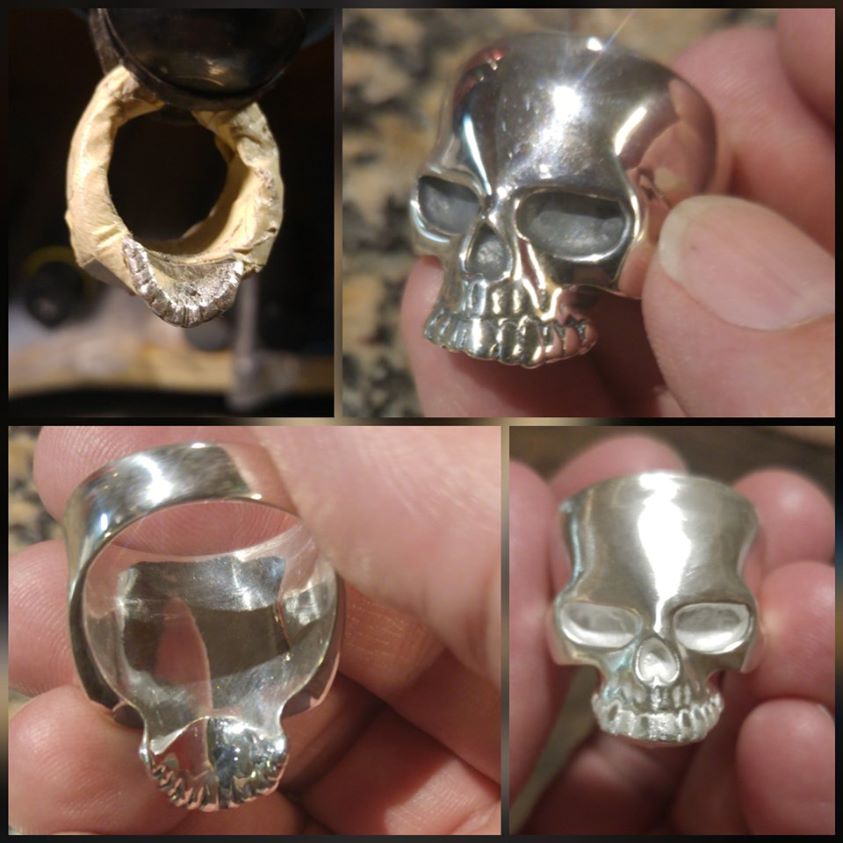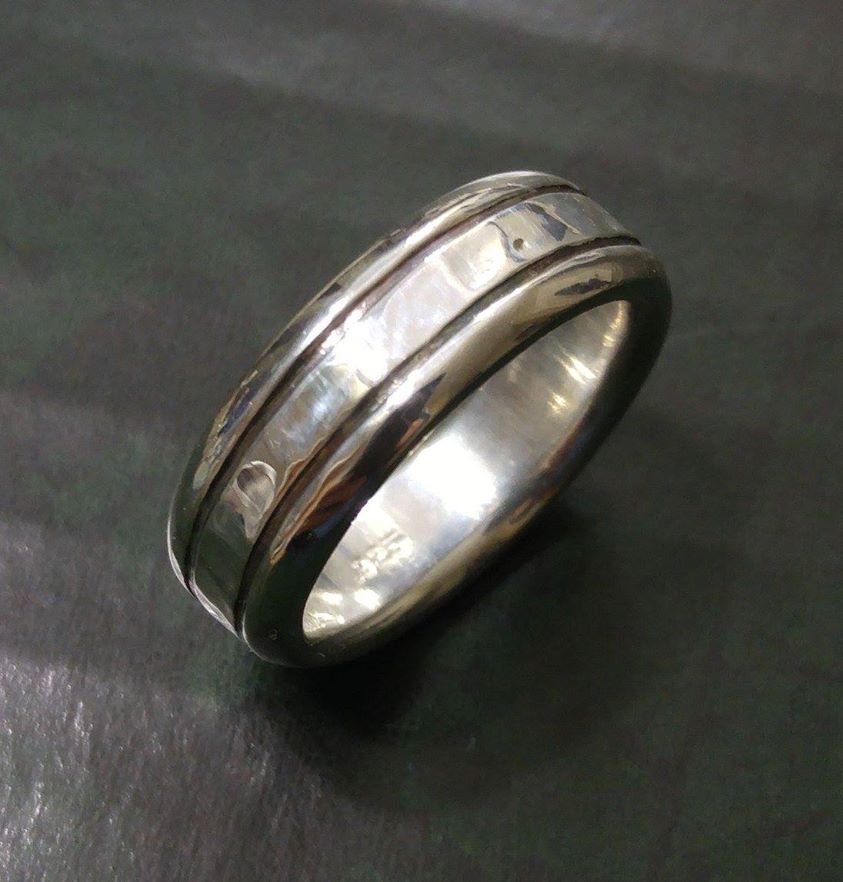I am not really into skulls, but when a good friend of mine brought me an old chrome-plated steel ring he had, wanting to know if I could replicate it in silver and make the silver ring a size 11-1/4 instead of the 8-1/4 the steel ring was, I figured I would give it a shot.

I wouldn’t ever recast other people’s work, but since his steel ring was completely unmarked and had the chrome plating flaking off in areas, I didn’t have a problem with it (and it would be a one-time replication for the owner of the original ring who would retain both rings if I was successful).
He gave me two old sterling rings he had bought in Mexico that he thought had fake stones in them to melt down and use for the casting, so I removed the “stones” from their bezels (yep, they were fake), and used that silver along with a little extra for the casting button.
I used Delft clay sand casting to cast it, utilizing Craig Dabler’s most excellent Acu-Pour casting flask and clamp set up (sorry for the shameless plug, but it really is great, and use his flask almost exclusively for my Delft clay casting now!).
It took nine tries to get a decent pour that I could use, as each pour up until then wasn’t complete. There would be a void or hole, usually around one of the eyes, that would just not fill completely.
I had tried relocating and/or increasing the the number of vent holes used in the clay to help air escape the voids as the molten silver took its place, and even made the sprue larger so the molten silver would enter the mold faster, but nothing seemed to help.
I was next going to try heating the flask rings with the clay mold in a toaster oven so the silver might not cool as quickly during the pour (one of Craig’s tips on his web site for gaining finer detail in casting with Delft clay), but on the ninth pour I got a cast where only the very bottom portion of the band did not fill completely. Since I would need to split the ring there anyway to make the ring three sizes larger, I ran with it.
A tip I discovered in an online video when casting rings in Delft clay is that when you have a ring that needs to be pressed into the clay upright (instead of pressed down horizontally as you would do with a simple band), is to fit a wooden dowel into the ring band, cutting its length just a little longer than the ring is wide. This allows the original template ring to be removed from the dowel, and the dowel fitted back into the clay, which then creates a void around dowel for the metal to flow into the negative space made by the template ring.
However, the wooden dowel only lasts 1-2 casts at most, since it gets heavily charred by the molten silver. On the second cast with that dowel, I tried filling the charred recessed areas with Delft clay, then wrapped it with paper to help bring it back to the correct thickness, rolling the dowel on the bench top to smooth things out, then glued down the edge of the paper to keep it from messing up the clay after releasing it and the ring from the mold.
That helped somewhat, but the dowel would continue to char and get more out of shape with each cast. After the second, and definitely the third cast it was almost impossible to get a smooth and even shape around the dowel again, no matter how hard I tried.
That’s when an idea came to me that what I could do is shape a wooden dowel (once more) to the correct size to fit inside the band, but only slightly smaller in diameter than I previously had to allow for a snug fit when wrapped with a strip of paper.
I readied another dowel and wrapped it in a strip of paper of the correct length and width, glued down the edge, and then slipped the dowel out of the paper tube created. I then filled the paper tube with Delft clay, carefully packing the clay with a smaller diameter dowel as it was filled.
Once packed, that gave me a solid, firm and correctly fitting clay “dowel” to use for the cast, and although it’s only good for a one-time use, it’s a *lot* easier to repeat that process than shaping a new wooden dowel or re-fitting a charred dowel to the correct size for each cast!

Another area that gave me problems when molding the ring in the Delft clay was an undercut area beneath the teeth. Every time I would try to carefully remove the steel ring from the clay, as clay had filled that area, it would pull up and deform that part of the mold. I solved this problem by using some of my wife’s polymer clay, packing it into place on the ring and smoothing it out to fit flush with the rest of the band.
After baking the ring with the polymer clay in place at 120 degrees (F) to harden it, I then used clear fingernail polish to temporarily “glue” it into place under the teeth until after I was able to get a good cast. That worked perfectly, though I would need to file and form that area on the silver ring after casting to get the undercut back like it should be to match the original.
I poured a small ingot and rolled it out to the correct thickness for the band, shaped it over a dapping die of the correct size, then cut a piece out of it that would fit the area on the bottom of the band that I had cut out and readied for it to bring it to the correct size, and soldered it on. I then shaped that area down to match the edges and contour of the cast, finished the sizing, and filed and formed the undercut under the teeth. After cleaning everything up, then oxidizing and polishing, the ring was ready to go.
My friend was super-exited to get his ring. It fit his finger perfectly and actually looked great on his hand (he’s a much bigger guy than I am), and we both couldn’t have been happier with the final outcome.
The weight of the ring came out to .813 troy oz., only .052 troy oz. less than the combined weight of the two rings he gave me to use for the silver, so it was virtually an even trade-off with the silver used on the two rings he gave me to melt down.
In fact, it was not only heftier than the steel ring I used for the mold due to differences in metal type and ring size, but the steel ring was hollowed out under the skull’s forehead, whereas on the silver ring the underside of the skull took on the shape of the round dowel, and therefore had no hollowed-out area.

